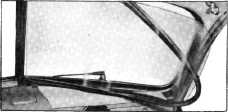1942 - 1947 CHEVROLET SHOP MANUAL
Section 1 Body
|
|
||||
|
1-13
|
||||
|
|
||||
|
easy operation of the
door lock bolt and for door
adjustment at the lock pillar. The striker plate attaching
screws thread into a movable plate inside
the pillar, and serrations on the
back of the plate as well as on the face of the pillar hold the
plate securely in place when the
screws are tightened.
These plates should be securely tight on the
pillars at all times. A loose or
even slightly loose striker
plate allowed to continue in this condition
over a period of time will not
only cause a noise, but
wear on the serrations will soon develop to the
point where the plate will not
remain tight even after a
thorough tightening.
In cases where serra-
|
breakage (other than by accident) should be determined
and corrected before attempting to install
a new glass. Many times a new
glass is placed in the
windshield opening without taking this fact into
consideration and as a result the
car comes back to the shop
with the new windshield cracked in
approximately the same place, the
owner is aggravated, and
the time, labor and material used in
glass replacement is lost.
The reason some
windshield glasses crack is that somewhere around the windshield
opening an obstruction or high
spot is binding on the glass, this
|
|||
 |
||||
 |
tions have worn, and a striker
plate will not stay tight,
correction may be made by
placing a thin square of
sheet lead between the
striker plate and the pillar.
Fig. 26. Reassemble the
screws and tighten securely.
Another method of repair is to
clean the plate area on the
pillar down to the bare metal
and then tin this surface
|
|||
|
Fig 27-Removing Right Windshield Glass
strain increases with wind pressure, extremes of
temperature, and the motion of the
car.
Following are
instructions for replacing a
cracked windshield glass:
1. On
the inside of the body, apply painters masking
tape along the top edge of the instrument
panel up to the edge of the
windshield garnish molding to prevent marring the finish.
2. Remove
the windshield garnish molding on the
side to be replaced, then the
center molding. (The garnish molding is made in three pieces;
right hand, left hand, and center.
It is most necessary to
remove the rear view mirror to
remove the molding.)
3. The
windshield glass rubber molding is made
in one piece which includes both
sides and center, the
glass being in a channel within the
molding as shown in Fig. 29. Run
a putty knife around the
rubber weatherstrip next to the
reveal molding on the outside of
the windshield to break
the seal—use care in this operation.
Push the damaged glass and rubber
molding toward the inside
of the car, applying pressure at the outer or pillar edge. Slip the
glass out of the channel in
the rubber molding as in Fig. 27.
NOTE—Unless it is
damaged, it is not necessary to disturb the windshield outer reveal
molding in making glass replacement.
4.
IMPORTANT-Clean out all the old
sealing compound from the
glass opening if any is
|
||||
|
with a soldering iron. The
serrations on the
|
||||
|
Fig. 26-Correcting
Worn Striker Plate Serrations
|
back of the striker
plate,
|
|||
|
when tightened against
this tinned surface, bite into the tin and prevent
movement of the plate.
NOTE-Do not attempt
to file the serrations on any striker plate as a means of repair—this
will result in destroying the hard wearing surface at this point and
allow more rapid wear.
Striker Plate Safety Catch
The little spring loaded safety catch in the door
lock striker plate is very
important from a safety
standpoint. A door not properly closed will be held
by this catch; they also prevent
complete opening of a door
through partial handle movement such
as might be caused by accidental
bumping against the door
handle.
Where any of these safety catches are damaged,
missing or in any way not serving
the purpose for which designed, a new lock striker plate,
including a new safety catch,
should be installed.
BODY GLASS
Windshield Replacement
In the replacement of
a cracked windshield glass, it is
very important that the cause of the glass
|
||||
|
|
||||